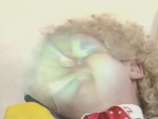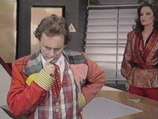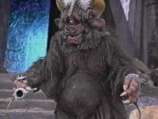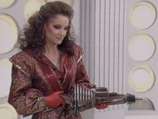 |
|
Regeneration
|
|
 The TARDIS is attacked by a powerful force whilst in flight and the Sixth Doctor and his travelling companion Melanie Bush are both knocked to the floor, unconscious. The TARDIS then materialises on the planet Lakertya, observed by one of the natives, Ikona. The TARDIS doors open and the renegade Time Lady known as The Rani enters - it was she who was responsible for the attack. She tells an unseen companion to leave the girl but to bring The Doctor. As she leaves, a lumbering, hair-covered creature enters the TARDIS. As the creature turns The Doctor’s prone body over, The Doctor’s face blurs and changes as he regenerates into a new form. The TARDIS is attacked by a powerful force whilst in flight and the Sixth Doctor and his travelling companion Melanie Bush are both knocked to the floor, unconscious. The TARDIS then materialises on the planet Lakertya, observed by one of the natives, Ikona. The TARDIS doors open and the renegade Time Lady known as The Rani enters - it was she who was responsible for the attack. She tells an unseen companion to leave the girl but to bring The Doctor. As she leaves, a lumbering, hair-covered creature enters the TARDIS. As the creature turns The Doctor’s prone body over, The Doctor’s face blurs and changes as he regenerates into a new form.
 Back in her lair The Rani finishes supervising two Lakertyans, Beyus and his daughter Sarn, as they store the kidnapped genius Einstein in a sealed cabinet alongside a number of others. The Doctor meanwhile regains consciousness in The Rani’s laboratory. He seems manic and disorientated but recognises The Rani. Examining her equipment he sees an asteroid which he identifies as being composed of Strange Matter. Back in her lair The Rani finishes supervising two Lakertyans, Beyus and his daughter Sarn, as they store the kidnapped genius Einstein in a sealed cabinet alongside a number of others. The Doctor meanwhile regains consciousness in The Rani’s laboratory. He seems manic and disorientated but recognises The Rani. Examining her equipment he sees an asteroid which he identifies as being composed of Strange Matter.
 Sarn runs away and encounters Melanie who had been rescued from the TARDIS by Ikona. Sarn, on seeing Melanie, panics and trips a wire which creates a transparent bubble, that traps her inside. The bubble bounces around the cliffs and rocks before exploding, reducing Sarn to a smoking skeleton. Having watched this The Rani orders Urak, a bat-like creature known as a Tetrap, to reset the trap while she injects The Doctor with something to give him amnesia. When The Doctor comes round, The Rani pretends to be Melanie in order to persuade him to repair a faulty machine in her laboratory. The Doctor though is puzzled and confused at first and refuses to continue to work for The Rani. He and The Rani return to his TARDIS to fetch a radiation wave meter. There, The Doctor changes his clothes, trying on those previously worn by the Second Doctor, the Third Doctor, the Fourth Doctor and the Fifth Doctor amongst others, before settling on a new outfit for himself. Sarn runs away and encounters Melanie who had been rescued from the TARDIS by Ikona. Sarn, on seeing Melanie, panics and trips a wire which creates a transparent bubble, that traps her inside. The bubble bounces around the cliffs and rocks before exploding, reducing Sarn to a smoking skeleton. Having watched this The Rani orders Urak, a bat-like creature known as a Tetrap, to reset the trap while she injects The Doctor with something to give him amnesia. When The Doctor comes round, The Rani pretends to be Melanie in order to persuade him to repair a faulty machine in her laboratory. The Doctor though is puzzled and confused at first and refuses to continue to work for The Rani. He and The Rani return to his TARDIS to fetch a radiation wave meter. There, The Doctor changes his clothes, trying on those previously worn by the Second Doctor, the Third Doctor, the Fourth Doctor and the Fifth Doctor amongst others, before settling on a new outfit for himself.
 | | A Confused Doctor |
|
 Meanwhile after the death of Sarn, Ikona believes Melanie to be in league with The Rani. She saves him from another of the bubble traps - thus convincing him that she is a friend. But then Melanie sees Urak and in trying to escape she stumbles into a bubble trap. Caught inside the bubble, Melanie finds herself bouncing over a cliff and landing on a lake. Ikona rescues her and they retrieve some weapons before being attacked by another Tetrap. Escaping, they head for The Rani’s fortress where Ikona meets Sarn’s mother Faroon who they tell about her daughter’s death. Meanwhile after the death of Sarn, Ikona believes Melanie to be in league with The Rani. She saves him from another of the bubble traps - thus convincing him that she is a friend. But then Melanie sees Urak and in trying to escape she stumbles into a bubble trap. Caught inside the bubble, Melanie finds herself bouncing over a cliff and landing on a lake. Ikona rescues her and they retrieve some weapons before being attacked by another Tetrap. Escaping, they head for The Rani’s fortress where Ikona meets Sarn’s mother Faroon who they tell about her daughter’s death.
 The Rani goes to fetch some vital material for The Doctor to use in the machine, but is captured by Urak who mistakes her for Melanie. Melanie meanwhile makes her way into The Rani’s control room where The Doctor believes her to be The Rani. The two travellers eventually convince each other that they are who they say they are by feeling each other’s pulses. Beyus helps them to escape by telling The Doctor the combination to unlock the control room door - it is 953, which is both The Doctor’s and The Rani’s age. However, outside the control room, Melanie finds the cabinets containing the kidnapped geniuses and sees that one is reserved for The Doctor. The Rani returns and, while Melanie, Beyus and Faroon escape, The Doctor hides in a dark Tetrap eyrie but The Rani locks the gate behind him and he finds himself surrounded by the awaking Tetraps. The Rani goes to fetch some vital material for The Doctor to use in the machine, but is captured by Urak who mistakes her for Melanie. Melanie meanwhile makes her way into The Rani’s control room where The Doctor believes her to be The Rani. The two travellers eventually convince each other that they are who they say they are by feeling each other’s pulses. Beyus helps them to escape by telling The Doctor the combination to unlock the control room door - it is 953, which is both The Doctor’s and The Rani’s age. However, outside the control room, Melanie finds the cabinets containing the kidnapped geniuses and sees that one is reserved for The Doctor. The Rani returns and, while Melanie, Beyus and Faroon escape, The Doctor hides in a dark Tetrap eyrie but The Rani locks the gate behind him and he finds himself surrounded by the awaking Tetraps.
 | | A Tetrap |
|
 Beyus though rescues The Doctor and tells him to go to the Lakertyan’s Centre of Leisure, where the reason for his obedience to The Rani will be revealed. The Doctor takes a micro-thermistor from The Rani’s machine and soon arrives at the Centre. There The Doctor and Ikona find that the Lakertyan people are lethargic and apathetic. There is a new globe-like device suspended from the Centre, but no-one will tell the distressed Ikona what it is for. The Rani, using a remote control, suddenly stops the globe from spinning, causing killer insects to emerge from it. The Doctor, Beyus and the other Lakertyans run screaming from the Centre to escape the swarm of insects. Beyus though rescues The Doctor and tells him to go to the Lakertyan’s Centre of Leisure, where the reason for his obedience to The Rani will be revealed. The Doctor takes a micro-thermistor from The Rani’s machine and soon arrives at the Centre. There The Doctor and Ikona find that the Lakertyan people are lethargic and apathetic. There is a new globe-like device suspended from the Centre, but no-one will tell the distressed Ikona what it is for. The Rani, using a remote control, suddenly stops the globe from spinning, causing killer insects to emerge from it. The Doctor, Beyus and the other Lakertyans run screaming from the Centre to escape the swarm of insects.
 Meanwhile Melanie is captured by the Tetraps and paralysed by a sting from the tongue of one of them. The Rani gets Faroon to give The Doctor a message that she will exchange Melanie for the micro-thermistor. Faroon delivers her message to The Doctor, who agrees to the proposed exchange. The Rani however, tricks him as the ‘Melanie’ she releases is revealed to be only a holographic projection. Having gained the micro-thermistor The Rani reinserts it in her machine, making it operational, but finds that the combined brain power of the kidnapped geniuses is still not sufficient for her purposes. Urak suggests that she link her own brain in. She refuses and orders that The Doctor’s cabinet be prepared. Meanwhile Melanie is captured by the Tetraps and paralysed by a sting from the tongue of one of them. The Rani gets Faroon to give The Doctor a message that she will exchange Melanie for the micro-thermistor. Faroon delivers her message to The Doctor, who agrees to the proposed exchange. The Rani however, tricks him as the ‘Melanie’ she releases is revealed to be only a holographic projection. Having gained the micro-thermistor The Rani reinserts it in her machine, making it operational, but finds that the combined brain power of the kidnapped geniuses is still not sufficient for her purposes. Urak suggests that she link her own brain in. She refuses and orders that The Doctor’s cabinet be prepared.
 The Doctor notes that The Rani has a fixed trajectory rocket launcher and realises that she must be working to meet a specific deadline. Ikona distracts the Tetrap guarding the entrance to The Rani’s fortress allowing The Doctor to enter. But he is caught by Urak, paralysed and placed in his cabinet. The Rani then enters a sealed room, followed by Melanie. Inside is a massive brain. With The Doctor’s input, the brain is able to start carrying out the calculations that The Rani desires. The Doctor notes that The Rani has a fixed trajectory rocket launcher and realises that she must be working to meet a specific deadline. Ikona distracts the Tetrap guarding the entrance to The Rani’s fortress allowing The Doctor to enter. But he is caught by Urak, paralysed and placed in his cabinet. The Rani then enters a sealed room, followed by Melanie. Inside is a massive brain. With The Doctor’s input, the brain is able to start carrying out the calculations that The Rani desires.
 | | The Rani |
|
 The Rani though realises that The Doctor is confusing the brain and orders him disconnected. The Doctor jumps from his cabinet, and he and Melanie then trap The Rani inside it. Back in the control room, The Doctor finds that The Rani’s rocket is intended to strike the asteroid of Strange Matter. He and Melanie watch a recording of a supernova on a screen. Melanie realises that The Rani is using the brain to come up with a lightweight substitute for the Strange Matter in order to detonate the asteroid. The Rani though realises that The Doctor is confusing the brain and orders him disconnected. The Doctor jumps from his cabinet, and he and Melanie then trap The Rani inside it. Back in the control room, The Doctor finds that The Rani’s rocket is intended to strike the asteroid of Strange Matter. He and Melanie watch a recording of a supernova on a screen. Melanie realises that The Rani is using the brain to come up with a lightweight substitute for the Strange Matter in order to detonate the asteroid.
 The Rani manages to escape from the cabinet and then explains her plan to The Doctor and Melanie. She needs helium-2. This will fuse with the upper Lakertyan atmosphere to form a shell of chronons - discrete particles of time - and then the brain will multiply, filling the gap between shell and planet, thereby creating a time manipulator, a cerebral mass capable of dominating and controlling time anywhere in the cosmos. Urak overhears The Rani boasting that all life on Lakertya will be destroyed. The Doctor gives the brain the correct formula and it devises loyhargil as the substance required. As the production of loyhargil starts in The Rani’s laboratory, The Doctor and Mel escape from the fortress. The Rani manages to escape from the cabinet and then explains her plan to The Doctor and Melanie. She needs helium-2. This will fuse with the upper Lakertyan atmosphere to form a shell of chronons - discrete particles of time - and then the brain will multiply, filling the gap between shell and planet, thereby creating a time manipulator, a cerebral mass capable of dominating and controlling time anywhere in the cosmos. Urak overhears The Rani boasting that all life on Lakertya will be destroyed. The Doctor gives the brain the correct formula and it devises loyhargil as the substance required. As the production of loyhargil starts in The Rani’s laboratory, The Doctor and Mel escape from the fortress.
 The Doctor helps remove control devices from the Lakertyans, that will reduce the wearer to a skeleton if removed, before returning to the fortress where he places them around the brain. Beyus stays to complete this task as The Doctor, Melanie and Faroon escape. The Doctor then confronts The Rani, who detonates the devices. The brain however completes its countdown and the rocket launches, but because of The Doctor’s interference it misses the asteroid. On realising that The Doctor has messed up her plans The Rani escapes to her TARDIS, but she discovers that it has been commandeered by the Tetraps who decide to take her as a prisoner back to their home world. The Doctor helps remove control devices from the Lakertyans, that will reduce the wearer to a skeleton if removed, before returning to the fortress where he places them around the brain. Beyus stays to complete this task as The Doctor, Melanie and Faroon escape. The Doctor then confronts The Rani, who detonates the devices. The brain however completes its countdown and the rocket launches, but because of The Doctor’s interference it misses the asteroid. On realising that The Doctor has messed up her plans The Rani escapes to her TARDIS, but she discovers that it has been commandeered by the Tetraps who decide to take her as a prisoner back to their home world.
 With The Rani defeated The Doctor gives the Lakertyans the antidote to the killer insects, but Ikona pours it away as he believes they should solve their own problems from now on. As the TARDIS dematerialises, with all the captured geniuses aboard the TARDIS so that he can return them home, Melanie tells The Doctor that he will take a bit of getting used to, which he replies: ‘I'll grow on you, Mel. I'll grow on you’. With The Rani defeated The Doctor gives the Lakertyans the antidote to the killer insects, but Ikona pours it away as he believes they should solve their own problems from now on. As the TARDIS dematerialises, with all the captured geniuses aboard the TARDIS so that he can return them home, Melanie tells The Doctor that he will take a bit of getting used to, which he replies: ‘I'll grow on you, Mel. I'll grow on you’.
|